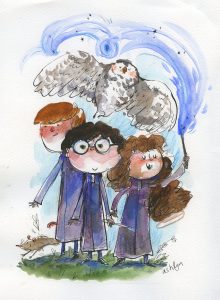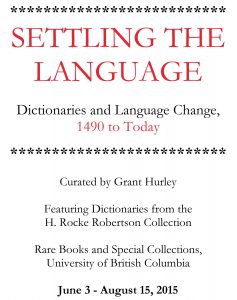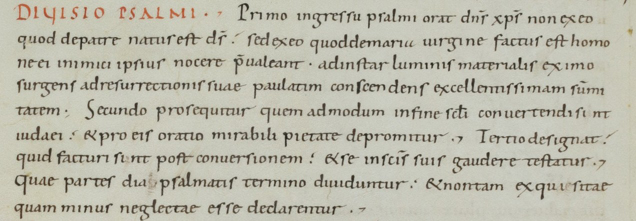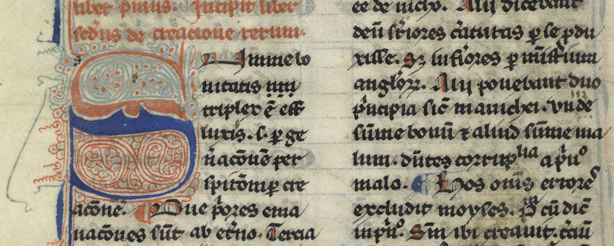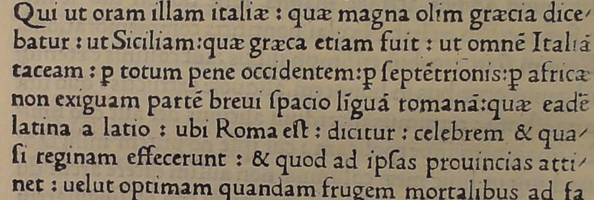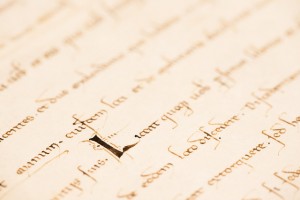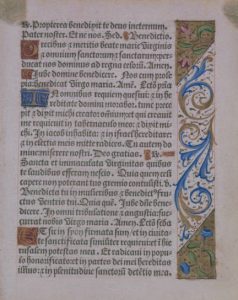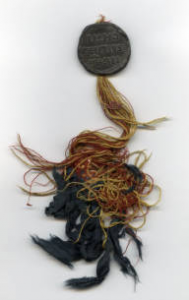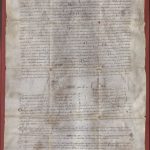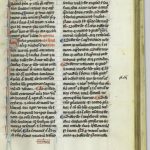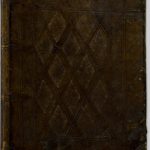New exhibition: The Illustrated Alice
Posted on October 8, 2015 @7:12 pm by cshriver
The Illustrated Alice: Celebrating 150 Years of Alice’s Adventures in Wonderland
October 6 through October 31, 2015
“And what is the use of a book,” thought Alice “without pictures or conversation?”
~ Lewis Carroll, Alice’s Adventures in Wonderland
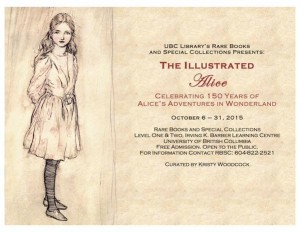 Join us for a sesquicentennial celebration of one of the most beloved books ever written. This year marks the 150th anniversary of the publication of Alice’s Adventures in Wonderland, and UBC Library’s Rare Books and Special Collections (RBSC) is proud to present The Illustrated Alice, a visual journey through 150 years of illustrations from Lewis Carroll’s classic work.
Join us for a sesquicentennial celebration of one of the most beloved books ever written. This year marks the 150th anniversary of the publication of Alice’s Adventures in Wonderland, and UBC Library’s Rare Books and Special Collections (RBSC) is proud to present The Illustrated Alice, a visual journey through 150 years of illustrations from Lewis Carroll’s classic work.
Curated by Kristy Woodcock, a children’s librarian and student in the Master of Arts in Children’s Literature program at UBC, the exhibition explores the enduring appeal of Alice through the ages.
Few literary works in history have been more widely adapted and referenced than Alice’s Adventures in Wonderland. Since its first publication in 1865, Alice has inspired many of the world’s greatest artists. While Sir John Tenniel is well known as the original illustrator, the book has been reinterpreted by hundreds of artists, including Blanche McManus, Arthur Rackham, A.E. Jackson, Ralph Steadman, Barry Moser, Tove Jansson, and Lisbeth Zwerger.
Featuring items from RBSC’s Alice 100 Collection, the exhibition showcases the many illustrated editions of Alice’s Adventures in Wonderland and Through the Looking-Glass, and What Alice Found There. One of the most famous artists on display is Salvador Dalí. Published in 1969, the Dalí Alice contains original woodcut remarques in a linen and leather case. Other highlights include the 1866 first edition of Alice illustrated by John Tenniel, a nineteenth century facsimile of Lewis Carroll’s original manuscript, and a calf-bound set that bears Alice Hargreaves’ signature.
The Illustrated Alice is on display at UBC Library’s Rare Books and Special Collections on the first and second floors of the Irving K. Barber Learning Centre from October 6 through October 31, 2015, and can be viewed Monday through Friday from 10 a.m. to 4 p.m. Beginning October 17, RBSC will also be open Saturdays from 12 p.m. to 5 p.m. The exhibition is free and open to the public. For more information, please contact Rare Books and Special Collections at (604) 822-2521 or rare.books@ubc.ca.
No Comments
Chelsea S.
Posted on October 8, 2015 @11:10 am by cshriver
|
||||||||||||||||
No Comments
“Dear Mr. Potter…with love from the Rain City”
Posted on October 8, 2015 @9:58 am by cshriver
We are delighted to announce a new exhibition curated by Rare Books and Special Collections at UBC Library, Harry Potter and the Rain City!
The exhibition spans three UBC’s library branches and features books from the Harry Potter series that have been newly added to the RBSC collection, as well as stories and memorabilia from Vancouver-area people and businesses most deeply impacted by the series.
Now we want you to share your Harry Potter story with other fans across Vancouver, British Columbia, and the world! How has the Harry Potter series impacted and inspired you? What are some of your best Harry Potter memories? What has Harry Potter and the Potter fandom meant to you? What would you say to Mr. Potter (or his creator, J. K. Rowling) if you had the chance? Submissions will be posted to the RBSC blog as new content is received.
The exhibition Harry Potter and the Rain City is free and open to the public, with locations at the David Lam Library (2nd floor), Koerner Library (3rd floor), and the Irving K. Barber Learning Centre, Ridington Room (3rd floor). For more information, please contact Rare Books and Special Collections at 604 822-2521 or rare.books@ubc.ca.
RBSC Research Agreement
New exhibition: Harry Potter and the Rain City
Posted on February 28, 2017 @2:38 pm by cshriver
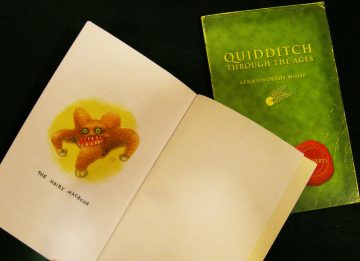
“Fantastic Beasts and Where to Find Them” with an original watercolour drawing by artist Jason Cockroft as a frontispiece, and “Quidditch Through the Ages.”
We are delighted to announce a new exhibition curated by Rare Books and Special Collections at UBC Library, Harry Potter and the Rain City!
Vancouver enjoys a number of profound and surprising connections to the beloved Harry Potter book series. Kidsbooks in Vancouver was the first Canadian bookstore to carry Harry Potter and the Philosopher’s Stone. UBC’s Quidditch club was the only Canadian team represented at the last Quidditch World Cup. The original Canadian editions of the series were published by a Vancouver company, Raincoast Books. And, Larry Campbell, the former mayor of Vancouver once donned robes and played the part of Professor Dumbledore at a Harry Potter midnight release party.
Now UBC Library celebrates the legacy of the series and Vancouver’s special relationship with “the boy who lived” with Harry Potter and the Rain City, an exhibition spanning three different Library branches. The exhibition features books from the Harry Potter series that have been newly added to UBC Library’s Rare Books and Special Collections, as well as stories and memorabilia from Vancouver-area people and businesses most deeply impacted by the series. Learn more about the exhibition and related events here!
Visit the exhibition, which is free and open to the public, from October 6 to December 11, 2015 at the following locations:
- David Lam Library (Level 2), 2033 Main Mall
- Koerner Library (Level 3), 1958 Main Mall
- Irving K. Barber Learning Centre (Ridington Room), 1961 E Mall, UBC
For more information, please contact Rare Books and Special Collections at 604 822-2521 or rare.books@ubc.ca.
No CommentsSilent Book Exhibition
Posted on February 28, 2017 @2:39 pm by cshriver
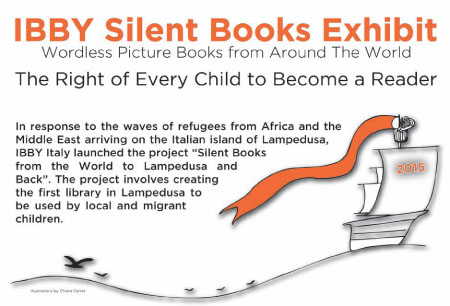 Rare Books and Special Collections at UBC Library is proud to host a new exhibition, The Right of Every Child to Become a Reader, sponsored by the International Board on Books for Young People (IBBY).
Rare Books and Special Collections at UBC Library is proud to host a new exhibition, The Right of Every Child to Become a Reader, sponsored by the International Board on Books for Young People (IBBY).
In response to the waves of refugees from Africa and the Middle East arriving in the Italian island, Lampedusa, IBBY launched the project “Silent Books, from the world to Lampedusa and back” in 2012. The project involved creating the first library on Lampedusa to be used by local and immigrant children. The organization went on to select a collection of silent books (wordless picture books) that could be understood and enjoyed by children regardless of language. These books were collected from IBBY National Sections, over one hundred books from over twenty countries.
Now IBBY has organized a traveling exhibition with stops in Vancouver, Edmonton, and Toronto. A collection of wordless picture books from around the world, curated by local illustrator, author, and teacher Kathryn Shoemaker, will be on display at Rare Books and Special Collections from October 1-23, 2015. Learn more about the traveling exhibition here!
The exhibition is free and open to the public Monday through Friday, 10 a.m. to 4 p.m. at Rare Books and Special Collections on the first floor of the Irving K. Barber Learning Centre.
No CommentsNew exhibition: Settling the Language
Posted on June 5, 2015 @8:43 am by cshriver
We’re very excited to welcome a new exhibition to Rare Books and Special Collections!
The exhibit, Settling the Language: Dictionaries and Language Change, 1490 to Today, is being mounted in support of the Dictionary Society of North America and Studies in the History of English Language conferences being held at UBC from June 5 to 7. The exhibition, curated by Grant Hurley, an MAS/MLIS student at SLAIS, will run until August 15.
Featuring items from the H. Rocke Robertson Collection of Dictionaries and other materials at RBSC, the exhibit celebrates the many forms of dictionaries. It includes 32 items, from early Latin and polyglot dictionaries, to the vital materials for Indigenous language revitalization, which all work in curious and contradictory ways to both fix, or settle a language. Brought together by the immense work of H. Rocke Robertson and other donors to RBSC’s collections, we hope you will enjoy the complicated and fascinating tales these texts tell us about our languages, identities, and linguistic ancestors. You can download the exhibition catalogue here.
You can visit the exhibition, which is free and open to the public, Monday through Friday, 10 a.m. to 4 p.m. at Rare Books and Special Collections on the first floor of the Irving K. Barber Learning Centre. For more information, please contact Rare Books and Special Collections at 604 822-2521 or rare.books@ubc.ca.
No Comments
The Changing Written Word
Posted on May 22, 2015 @10:22 am by cshriver
In honour of our new exhibition, Papal Parchments and Blackletter Books, here’s a lesson on the history of the written word and why the text you’re reading now looks the way it does. Thanks so much to the exhibition’s curator, Robert Makinson, for this fascinating look back.
The Changing Written Word
The alphabet used by Western European languages today, including English, French, German, Spanish, Italian, and many others, is usually called the Latin alphabet or the Roman alphabet because it was first used by the ancient Romans to write their language, Latin. But although the letter forms may look familiar, they wrote their books very differently, so differently that they are nearly unintelligible to modern readers:
This image, taken from a reproduction of a Latin copy of Vergil from the fourth century, was produced during the later Roman Empire. While we can make out individual letter forms, such as the first seven letters spelling out the Latin word INFELIX (“unfortunate”), the text is very difficult to parse and read; this is because there are no spaces between words, no punctuation, and the letters are all majuscule, like our modern uppercase alphabet.
Four hundred years later, books would look very different. During the time of Charlemagne (c. 748-814), the emperor of the Franks (ancestors of the French), a new script was developed that was specifically designed for easy reading. Called Carolingian minuscule or Caroline minuscule—minuscule letters look like today’s lowercase alphabet—it allowed manuscripts to be produced with much fewer errors and eliminated much misunderstanding among readers.
Many familiar features are starting to appear: there are spaces between words and some punctuation is present. But most importantly, distinctions are made between majuscule letters, found in titles and at the beginning of sentences and phrases, and the minuscule letters present everywhere else. These minuscule forms are very similar to the forms used by most modern fonts, and Caroline minuscule would dominate European books for nearly four hundred years, even inspiring the script used by the papacy for its official documents like papal bulls. After 1150, however, Caroline minuscule was gradually supplanted by a more compact, angular script called textualis, better known today by the misnomer “Gothic.”
Eventually, Caroline minuscule was revived by the Italian Humanists in the fifteenth century, who wrongly believed that it was the script used by the ancient Romans. This adapted version of Caroline minuscule, which came to be known as Humanistic minuscule, in turn inspired many of the typefaces used by early printers. The very modern- and familiar-looking typeface below is representative of many books printed during this early period.
These typefaces, though they were subject to changing tastes over the centuries, became the basis for the fonts that we use today. The way we read and write, then, descends directly from the innovations adopted and adapted during the Middle Ages, especially the time of Charlemagne.
To see some of these documents in person, please join us for the exhibition Papal Parchments and Blackletter Books: How the Middle Ages Shaped the Way We Read, 1245 AD to UBC, which runs from May 1-31, Monday through Friday, 10 a.m. to 4 p.m. at Rare Books and Special Collections on the first floor of the Irving K. Barber Learning Centre. For more information, please contact Rare Books and Special Collections at 604 822-2521 or rare.books@ubc.ca.
No CommentsMore medieval fun (online)
Posted on May 20, 2015 @9:32 am by cshriver
We’re pretty proud of our library and archival school here at UBC. Rare Books and Special Collections benefits greatly from the talented students that take on co-ops, work learn positions, and special projects here. Our new exhibition, Papal Parchments and Blackletter Books, was curated by current library student, Robert Makinson, and a fellow student (and a great designer) kindly offered to create a web-based exhibition catalogue for the project. You can browse Anne Darby’s site and learn more about medieval manuscripts and the RBSC exhibition here.
Papal Parchments and Blackletter Books is free and open to the public, and runs from May 1-31, Monday through Friday, 10 a.m. to 4 p.m. at Rare Books and Special Collections on the first floor of the Irving K. Barber Learning Centre. We hope to see you there!
No CommentsHow It’s Made: Medieval Manuscripts
Posted on May 19, 2015 @1:04 pm by cshriver
In honour of our new exhibition, Papal Parchments and Blackletter Books, here’s a lesson on how medieval manuscripts were made, courtesy of the exhibition’s curator and a student in UBC’s School of Library, Archival, and Information Studies, Robert Makinson.
How Manuscripts Are Made
Manuscript leaves are usually made from vellum, a term denoting calfskin; other animal skins were also used, however, and these are properly called parchment. Their material makes manuscript pages much thicker and heavier than paper, so they resist tearing and other forms of trauma better, but they react badly to changes in temperature and humidity: this causes the wrinkles and wave patterns you sometimes see in damaged manuscripts.
When the animal had been skinned, the material was submerged in a lime solution for several days, which prepared it to receive inks and pigments; afterwards it was stretched upon a wooden frame to dry evenly. Then pages were cut from the skin, and the artisan used a knife to remove hair from the “outside” of the skin and a pumice stone to reduce imperfections. If you look carefully, you can actually tell which side of the skin you are looking at, thanks to scars, veining, and other marks! Usually, these sheets were folded one or more times, creating what we call folios or quartos; many were gathered and bound together to make the manuscript. The front and back of each sheet were called the recto and verso, respectively.
There were several kinds of inks used during the medieval period:
- Similar to modern inks because they adhere to the surface of the material, carbon gums were used for most early manuscripts, and were made by mixing carbon-based materials like charcoal or lamp-black with a thickening agent like gum arabic.
- Later manuscripts were usually written with iron galls, which were made by combining tree galls, usually from oaks, and iron from nearly any source. They were much more cheaply made and used almost exclusively in the later Middle Ages, but they can cause more damage to manuscripts and fade to brown over time. Most manuscripts in this exhibition were written with iron gall inks.
- Red inks were made by pouring acidic substances like vinegar or urine on lead sheets and repeating the process until the desired hue was achieved. The process usually took several weeks, but since red inks were necessary for rubrication, this was a fairly common practice.
- There are dozens of different medieval recipes for making other colours of ink, and they vary widely in materials and manufacturing processes.
Pigments were used for illuminated manuscripts that feature colourful illustrations. Our collection does not have much illumination, but like coloured inks, these pigments come from a wide variety of sources: some were naturally-occurring compounds, while others were manufactured artificially. Certain pigments have weathered the years better than others, since they can fade, dissolve, or even explode without proper storage conditions!
To see some of these incredible documents in person, please join us for the exhibition Papal Parchments and Blackletter Books: How the Middle Ages Shaped the Way We Read, 1245 AD to UBC, which runs from May 1-31, Monday through Friday, 10 a.m. to 4 p.m. at Rare Books and Special Collections on the first floor of the Irving K. Barber Learning Centre. For more information, please contact Rare Books and Special Collections at 604 822-2521 or rare.books@ubc.ca.
No CommentsNew exhibition: Papal Parchments and Blackletter Books
Posted on May 15, 2015 @3:33 pm by cshriver
Rare Books and Special Collections at UBC Library announces a new exhibition!
Papal Parchments and Blackletter Books: How the Middle Ages Shaped the Way We Read, 1245 AD to UBC
This fascinating exhibition tells the medieval and early modern story of the written word using RBSC’s fantastic collection. Two recent acquisitions are of particular note: a papal “bull,” or legal decree, issued by Pope Innocent IV in 1245 (whose seal is depicted at the right); and a textbook used at the University of Paris during the late thirteenth century. But the exhibition also showcases pieces that have been here for decades, such as a single leaf from the Catholicon, a Latin dictionary probably printed in 1460 by Johannes Gutenberg, the inventor of typography. We also have a 1331 legal document donated to the library by the Bulwer family, whose ancestors are named in the manuscript and who moved from England to Vancouver in 1887.
The items found in this exhibition also explore the intersection between manuscripts and early books called incunabula (English “incunables”), texts printed during the period 1450-1500: the Biblia Pauperum (“Bible for the Poor”) is a printed book bound in the remnants of a medieval manuscript; and our copy of the Roman emperor Justinian’s Institutes has many annotations added by hand and even has fragments of an old manuscript book in its binding!
These pieces were produced over a period of nearly three hundred years, from 1245 to 1525, and together they tell the story of the written word as it moved towards the forms we use today. But we are part of the story too, moving that history forward as we write in English, French, or any of the other European languages.
You can explore the objects featured in the exhibition through the gallery below, but there is nothing quite like experiencing these treasures in person. The exhibition, which is free and open to the public, runs from May 1-31, Monday through Friday, 10 a.m. to 4 p.m. at Rare Books and Special Collections on the first floor of the Irving K. Barber Learning Centre. For more information, please contact Rare Books and Special Collections at 604 822-2521 or rare.books@ubc.ca.
- Bull of Innocent IV, Lyons, 1245. BX1547 .T74 C373 1245
- Reproduction of Bull of Innocent IV, 1319. Innsbruck Tiroler Landesarchiv, Urk. I 493
- Hugh Ripelin, Compendium Theologicae Veritatis, France, c. 1300. BX 890 .H76 1320
- Gradual, c. 1450. M2148 .L4 I8 1400
- Martianus Capella, De Nuptiis Philologiae et Mercurii et al., 1500. PA 6511 .M2 1500
